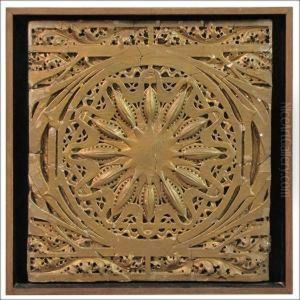Louis H. Sullivan Paintings
Louis Henri Sullivan, commonly known as Louis H. Sullivan, was a pioneering American architect, and has been called the 'father of skyscrapers' and 'father of modernism.' He is considered by many as the creator of the modern skyscraper, an architectural genre that developed in the United States during the late 19th century. Sullivan was born on September 3, 1856, in Boston, Massachusetts, to a Swiss-born mother and an Irish-born father. From an early age, he showed a keen interest in architecture and drawing, which was encouraged by his parents.
Sullivan's formal education in architecture began at the Massachusetts Institute of Technology (MIT), the first school of architecture in the United States. His education was short-lived, however, as he left after one year to pursue a more hands-on approach to learning. He moved to Philadelphia and then to Chicago, where he joined the office of architect Dankmar Adler in 1879. In 1881, Sullivan became a partner in the firm, which was then renamed Adler & Sullivan. This partnership would last for 14 years and would produce some of the most significant architectural works of the period.
During his career, Sullivan became known for his tall office buildings, especially the Wainwright Building in St. Louis, Missouri (1890-1891), and the Guaranty Building in Buffalo, New York (1894-1895). His design philosophy was famously encapsulated in his dictum, 'form follows function.' Sullivan believed that the design of a building should directly relate to its purpose, a radical departure from the historically eclectic styles that had been popular. His work was characterized by his elaborate and expressive ornamentation, which was often inspired by natural forms and is considered a precursor to the Art Nouveau movement.
Despite his significant contributions to architecture, Sullivan's career declined after the turn of the century. His insistence on aesthetic expression over commercial viability led to fewer commissions. Moreover, his ideas were at odds with the prevailing Beaux-Arts architectural style that was taught at the American architectural schools of the time, which emphasized historical forms and ornamentation. By the time of his death on April 14, 1924, in Chicago, Illinois, Sullivan had been largely forgotten by the mainstream architectural community. However, his theories laid the groundwork for modernist architecture, and he influenced future generations of architects, notably Frank Lloyd Wright, who had worked for Sullivan early in his own career.
Today, Louis Sullivan is remembered as a visionary who played a crucial role in the development of American architecture. His buildings have been extensively studied, restored, and celebrated for their innovation and beauty. He has been the subject of numerous books and his legacy is preserved in the structures that continue to stand as testaments to his genius and foresight in the field of architecture.
